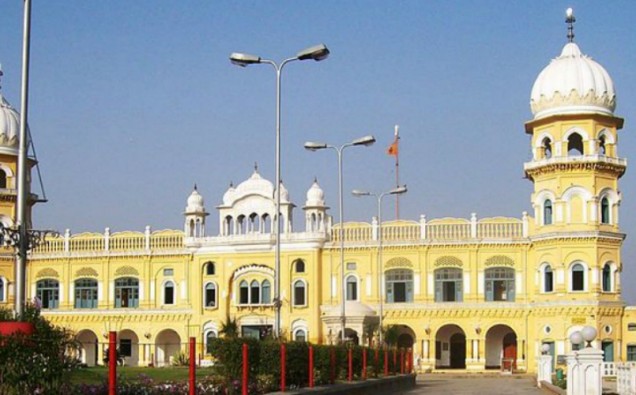
Gurdwara Nankana Sahib, Photo by Jeev Wikipedia
This year the International Day for Monuments and Sites is dedicated to the theme “Cultural Heritage & Sustainable Tourism.”
While designating 2017 as the International Year of Sustainable Tourism for Development, the United Nations General Assembly noted “the importance of international tourism in fostering better understanding among peoples everywhere.”
According to UNESCO figures, cultural tourism presently accounts for close to 40 per cent of world tourism revenues.
Cultural heritage sites in general, and those inscribed on the UNESCO World Heritage List in particular, generate substantial revenues and employment from tourism. “Tourism is the most significant link between heritage assets and sustainable development. Due to its capacity for job creation, poverty reduction, human development and environmental sustainability, tourism can benefit countries in a number of ways, offering an important contribution to the overall national growth in many counties,” the UNESCO said in a message.
But in recent times a lot of cultural heritage sites and monuments have been damaged and devastated in ongoing conflicts between militants and states and between communities – the demolition of Babri Mosque in India in 1992, the damage to the ancient statues of Buddha in Bamiyan, Afghanistan in 2001, desecration of several shrines in Pakistan at the hands of Taliban and more recently destruction of sites in Syria and Iraq including churches, mosques, shrines and famed Temple of Bel in Palmyra in 2015.
Director-General Irina Bokova says the destruction of cultural property went beyond a material and aesthetic loss.
Placing heritage and culture as tools for peace and dialogue at the heart of the political agenda, she said in a significant statement.
The preservation of cultural and historical monuments must become a priority, not remain an option.
But the question is how to proceed with this restoration of such sites. Despite 15 years of engagement with Afghanistan, rich nations have not been able to revive destroyed heritage of the country. Similarly, countries that overcome challenges take a long time in reviving the damaged site.
One of the most prominent examples in South Asia has been renovation and preservation of the Sikh holy sites in Nankana Saheb in Pakistan’s Punjab province. Some other monuments like the Taj Mahal have also been preserved. Similarly collaborations in the field of performing arts, films and music, and sport exchanges have been found to be huge factors in promoting mutual goodwill and understanding between the two South Asian nuclear-armed neighbors. But at the moment exchange visits and collaborations are in limbo due to escalating violence in Jammu and Kashmir, where Indian forces have used brutal tactics to quell mass protests.
In the case of Nankana Sahib, the birthplace of Sikh spiritual leader Guru Nanak and the venue has served as an avenue of understanding and relationship between the Indian Sikh community and Pakistan, therefore providing a platform to advance pace dialogue. Recently, an Indian media report cited a Sikh soldier, saying he cannot even think of bombing a country – Pakistan – that houses one of the holiest places in the Sikh religion.
However, in the midst of many disconnects, faith tourism between India and Pakistan has survived political and diplomatic tensions as the Sikh pilgrims are welcomed to visit Pakistan in large numbers to pay their respects to the founder of their religion.Similarly, a large number of Pakistani Muslims visit India as pilgrims to revered Sufi shrines.
In fact, both India and Pakistan continue to facilitate each other’s pilgrims under an agreement. Only last week, around 1,300 Sikhs arrived in Pakistan last week to attend the Baisakhi seasonal festival at Gurdwara Panja Sahib, Hassan Abdal.
From the Pakistani side, Pakistan’s religious ministry has invited applications from pilgrims who plan to visit India for the annual Urs of Hazrat Mujaddid Alf Sani Sirhind. The annual Urs will be held from November 16 to 23 this year. Ballot, if required, for 200 Pakistani pilgrims will be held on May 19, ministry, according to a statement.
The people-to-people contacts via religious tourism provide a huge bridge-building opportunity in the face of official disconnect. The importance of such interfaith activity has increased all the more as minorities in both countries are victims of violence. In India since the rise of Hindu nationalist BJP to power, militant wings and vigilantes have been targeting Muslims on suspicion of eating beef, and in Uttar Pradesh, several meat shops have been shuttered down as Hindus believe cows are sacred and should not be slaughtered.
Figures reveal that very year around six major Urs take place in India. About 1,000 pilgrims from Pakistan attend five Urs, while 500 participate in Ajmer Sharif’s Urs alone.
The two countries have done well in this respect, leaving a window of opportunity open, although a lot remains to be done to ensure that religious places of all communities are preserved and protected.
But not in all cases the state at central or local level can take care of cultural sites and places of worship.
Recently, a conference on Silk Road in China emphasized the role the young people can play in protecting and maintaining historic monuments. But unless there is enough financial support form both the states and all segments of the societies, particularly the affluent, protecting cultural heritage will remain a daunting challenge.
Muhammad Luqman from Lahore contributed to this report.





![Dargah of Moinuddin Chishti Photo Mujeerkhan at English Wikipedia [GFDL (http://www.gnu.org/copyleft/fdl.html), CC-BY-SA-3.0 (http://creativecommons.org/licenses/by-sa/3.0/) or CC BY-SA 2.5-2.0-1.0 (http://creativecommons.org/licenses/by-sa/2.5-2.0-1.0)], via Wikimedia Commons](https://www.viewsnews.net/wp-content/uploads/2017/04/Sufi_photos_051-300x225.jpg)








